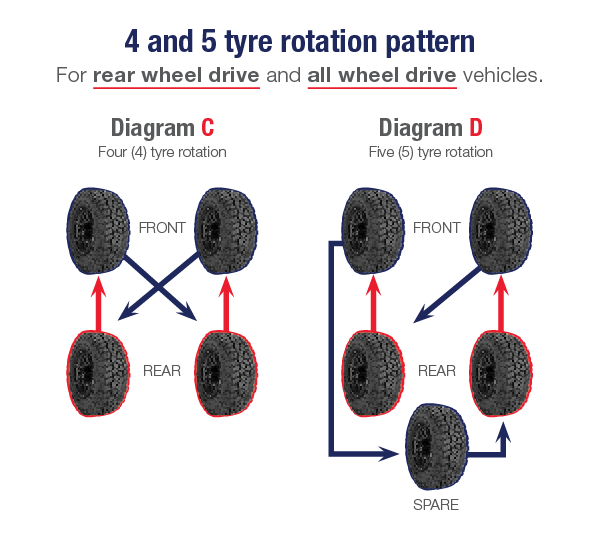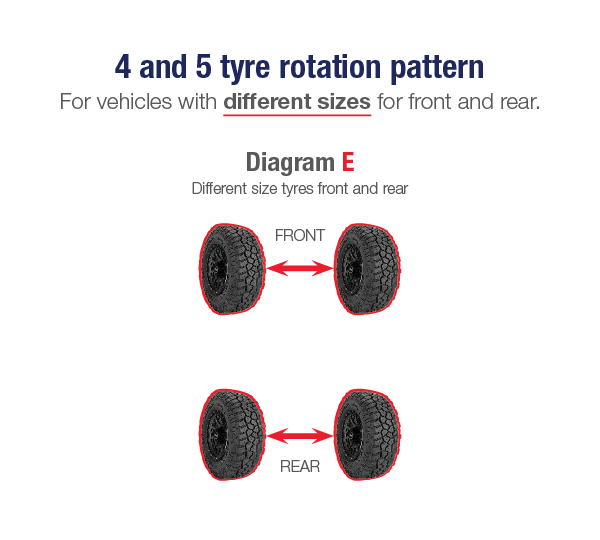Tyre rotation can be beneficial in several ways. When done at the recommended times it can prolong the life of your tyres. Plus, rotating your tyres can even provide performance advantages in both handling and traction.
When should you rotate your tyres?
Your owner’s manual will tell you how often you should rotate your tyres, as a rule of thumb, it’s every 10,000kms.
Why should you rotate your tyres?
Each tyre on your vehicle carries a different amount of weight. Particularly the rear tyres if you’re carrying heavy loads. By rotating your tyres, they are always trading places for more uniform wear.
The advantage is that all your tyres wear at the same rate, allowing them to perform at their best, equally. And when your tyres need replacing it is better to buy them in a set rather than in pairs. Replacing sets helps to maintain the original handling balance.
Note: rotating your tyres won’t correct wear problems due to incorrect tyre pressure or mechanical issues.
Fitting a pair of new tyres
If you do need to fit only two new tyres, it’s recommended that you always replace the rear tyres. Research has proven vehicles are more controllable if rear tyres have more grip. They’re least likely to fish-tale as a result, regardless of whether it’s a front-wheel drive or a rear-wheel drive.
Plus, new tyres have deeper treads and are less likely to suffer damage when driving off-road. Yet, if tread depth varies by more than 2-3mm from front and back you should consider replacing all tyres. This will help to maintain balanced steering and braking.
4 tyre rotation
If your vehicle is a front-wheel drive with non-directional Cooper tyres, rotate your tyres as shown in Diagram A.
For a rear-wheel drive or all-wheel drive vehicle, rotate you tyres as shown in Diagram C.
Or if your vehicle has different size tyres on front and back, rotate your tyres as shown in Diagram E.
5 tyre rotation
Five tyre rotation means the spare tyre also gets inspected, and if required can go into service. This ensures that all five tyres wear the same and maintain even tread wear.
Plus, as a bonus, you’ll be able to achieve 20% more kilometres before having to replace the entire set.
The spare tyre can only go into the rotation if it’s the same size, type and load rating. It’s also important to note that some spare tyres are labelled for temporary use only. These cannot be included in a five-tyre rotation program.
The five-tyre rotation, when applied to most 4×4 and AWD vehicles, will prevent driveline damage. Particularly if the spare gets fitted with partially worn tyres.
If you have front-wheel drive, rotate your tyres as shown in Diagram B.
If you have a rear-wheel drive or an all-wheel drive, rotate your tyres as shown in Diagram D.



The most important part of your tyre is the tread. It gives you the traction to stop and hold the road on curves.
Tyre tread also squeezes water out from under the tyre, which helps to reduce hydroplaning. This is where a vehicle rides upon a layer of water and becomes difficult to steer or stop.
There are several things you can do to help extend the tread life on your tyres.
- Make sure your tyres are balanced at the time of fitting. Balancing involves placing small weights on the rim to counteract heavy spots, or slight variations in weight, in the wheel and tyre assembly. If a tyre is not balanced, it will shimmy as you drive resulting in uneven treadwear.
- Make sure that your vehicle’s suspension is properly aligned. Otherwise, your tyres will ride at an angle and wear unevenly. As a result, you may experience handling problems. A vehicle can become misaligned gradually over time, or suddenly when you hit a bump or pothole.
Have your tyres both balanced and aligned periodically. Also, have it checked, if you notice anything unusual, such as pulling to one side or vibrating.
Find an authorised Cooper Tires stockist and fitter here.
SAFETY NOTICE: Your spare tyre must be the same diameter, construction, and load index as all tyres on your vehicle.

